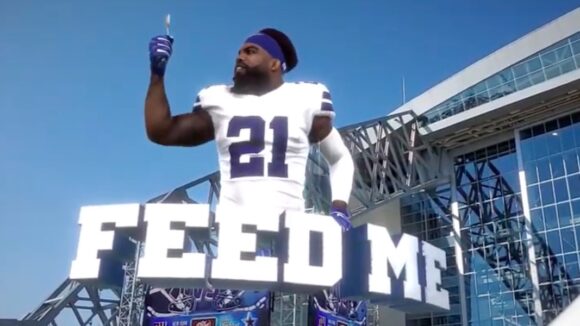

With Gilda, Nexus Studios Wants To Turn Venues Into Augmented Reality Playgrounds
Last month, people attending a Dallas Cowboys game were shown more than just football. At the AT&T Stadium, the Cowboys’ home, fans with a 5g-enabled Samsung cell phone were treated to a range of groundbreaking features in augmented reality (ar).
On their way into the game, they held their phones up to watch 100-foot holograms of Cowboys players standing aloft on the stadium’s architecture. During play, their screens projected live stats above the pitch. At halftime, holograms of the players returned to the pitch to take on giant robots; the fans controlled the players through their phones.
This smorgasbord of zany ar experiences came courtesy of Nexus Studios (in partnership with AT&T and Samsung). The production company, which is based in L.A. and London, U.K., spent two years developing new systems and technologies to extend the possibilities of ar. It has now integrated these into a new location-based ar toolkit, Gilda.
Essentially, Gilda generates a three-dimensional, 1:1-scale digital model of a venue, with which digital creations can interact in sophisticated ways — for instance, the player’s hologram scaling the stadium’s exterior.
The platform draws on a Visual Positioning System (developed by Scape Technologies), which Luke Ritchie, Nexus’s head of xr and interactive arts, describes in a blog post as a more accurate alternative to GPS. Its precision lets users engage with the ar content from all kinds of angles, and ensures that the content scales correctly and moves in the right places.
Hence why football fans were able to participate, regardless of where they were sat. And hence why Gilda differs from familiar ar experiences like Pokémon Go, where the digital content merely hovers in real space.
“We want ar characters or objects to occlude behind balconies, doors, or rooftops. We want ar to know the physical dimensions of the real world. We want 80-foot football players to jump up and touch the jumbotron,” writes Ritchie.
AT&T Stadium also happens to be the world’s first 5g-enabled stadium. This emerging technology, coupled with Nexus’s proprietary compression tool, meant that the footballers’ holograms could be streamed in very high quality. But Ritchie adds that the toolkit is also designed for 4g, which remains far more common.
The demonstration at AT&T was basically an elaborate proof of concept. With Gilda, Nexus hopes to extend the tech to other venues. As its website puts it, “Gilda can reimagine any venue as a limitless world of wonder. Be it a stadium, a theme park, a cultural site, or any public space, Gilda elevates the live experience.”

.png)